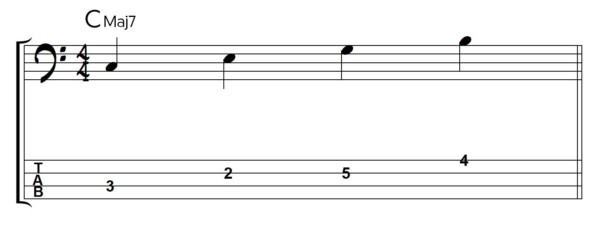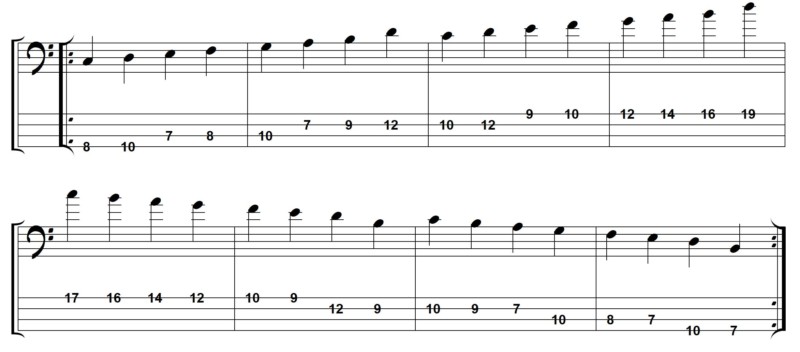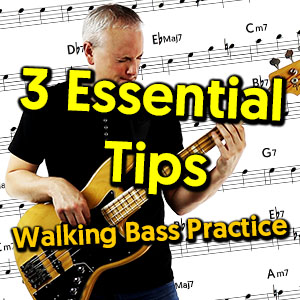This week we’re looking at walking bass lines and specifically, how to walk over a single chord for long periods of time.
Single Chord Walking Practice?
Many players new to walking bass find a lot of information regarding playing through changes like 2-5-1 and blues progressions. That practice is absolutely vital and probably most useful when learning to walk, but there isn’t the same attention paid to walking over a single chord.
Learning to walk over a single chord is a really useful skill. Modal jazz is the most obvious place for this kind of application but learning to walk over one chord is also great for practicing chord tones and scales over the whole fretboard and it also gives you the chance to experiment with a variety of chord tones, scales and chromatic notes within one tonality.
First Things First: Chord Tones
Let’s just jump straight into a single chord. Let’s take a basic Cmaj7 chord. For those of you with very little harmony knowledge, the C major 7 chord is a C major triad with a major 7th on the top. So we have the notes C E G and B.

These chord tones are your first port of call when looking to create any kind of content over a chord. Chord Tones are the Consonant notes, because they are ‘in’ the chord.
Any other notes (non chord tones) are outside the chord and will rub up against them creating Dissonance.
Dissonance is actually a good thing and an essential part of creating any kind of musical line because you don’t want everything to be totally consonant all the time, it would be pretty boring. But we do need to start with the chord tones so we can get out heads around the skeleton of that chord.
Try playing the following arpeggio lines in 1 and 2 octaves over the C Major 7 practice track (see below this content)
C Major 7: One Octave

C Major 7: Two Octaves

As you can hear there. Chord Tones work fine and all fit perfectly well with the chord but we have a few problems.
Arpeggios are very angular with lots of leaps. It’s not very smooth. Arpeggios like this can be great when playing through changes in a more confined area or if you need to cover wider distances very quickly. But when playing over a single chord things can get very boring very quickly.
Let’s Add Scales Into The Mix!
Let’s look at adding some extra notes in there. We’re going to do this in two stages: First we want to add the notes of the appropriate chord scale into the mix which basically bridges the gaps between those arpeggio notes making for a smoother line.
For the C Major 7 chord we’ll be using the C Major scale: C D E F G A B.
To play the scale over the chord in 4/4 we need to use a little turnaround on the B. Try playing this 1 octave lines as follows:

We can use the same method of adding a note to our line in creating a 2 octave scale pattern:

Once again, this sounds OK but playing up and down a linear scalar line get be pretty boring over long periods of time.
Root-5th Targeting
Before we look at chromatics let’s just have a look at an important point in creating these lines over multiple bars.
In the previous scale line we started our journey on C and worked up the major scale to land on G for the 1st beat of the second bar. This is a very common way of playing over multiple bars.
The fifth is the closest note to the root in the overtone series and acts as both reinforcement of the root note and provides progression by way of the 5 to 1 cadential effect.
So that’s a big tip: If you want to walk over a single chord for multiple bars, try working from the root to the 5th to the root to the 5th . It’s a good first step and always provides a strong bass line.
Chromatic Notes
Next let’s add chromatic notes into the mix. Chromatic notes simply bridge the gap between scale notes and can be used as passing/approach notes when leading into chord tones.
By using our system of root to 5th we can create a smoother ascending scalar line by adding the note Bb between A and B or the G# between G and A:
Passing Note Between 6th and 7th :

Passing Note Between 5th and 6th:

We can extend these lines over two octaves (also try mixing the lines up):
Flat 7 in 2 Octaves:

Sharp 5 in 2 Octaves:

If we want to descend we can try another couple of chromatic notes, maybe try the Ab again which leads us nicely into the fifth:

Or we can try the Db between the D and the C, which leads us smoothly into the root on beat 1:

We can combine these lines to create a multitude of variations over 2 octaves. Try this following example over the track (in the video I combine all of these lines in a variety of ways on the fly):

Building A Walking Vocabulary
Now we’re getting somewhere. We know the chord tones are our basic framework and the important points of resolution. We can also add scalar notes and chromatics to help bridge those gaps and add a little smoothness.
But things are still boring, we’re playing a scale up and down. What we really need to do is start looking at phrases and vocabulary.
The key is to start looking at simple 1 and 2 bar phrases. We’ve been looking at the recurring root/5th targeting so let’s look at a few short phrases we can use all over the fretboard. These phrases can be seen as words that we can then combine into sentences and paragraphs over a longer period of time:

Practice these ‘words’ with a variety of fingerings in different registers. Start in one area and then move up through different positions in order to shift into different octaves.
Further Practice
You can apply this practice to any chord type. I’d recommend practicing the 4 main chord types first, major 7, dominant 7, minor 7 and minor 7b5 and in all keys.
The same concepts can all be applied: Start with chord tones and then add scales (major for major 7, mixolydian for dominant 7, dorian for minor 7 and Locrian for minor 7 flat 5).
Then start to add the chromatic notes into the mix. You’ll find that the same vocabulary can be used for all of these chord types with a simple alteration to the chord tones.













This is absolutely one of the best lessons you’ve presented on walking bass. Practical and informative!!!! Please keep up your walking bass lessons. Thanks a lot for all you do with bass instruction.
Dear Mark i love jazz but i have never understood how substitution works from a bass players point of view . For example ( this may be a very wrong question ) but what if i play a different substitution than the rest of the band for example if i play a c bass when the chord people are playing is an e minor seventh chord then we would get a c major ninth . Doesn’t that put the whole substitution sequence out Help !! i really dont understand . If you could recommend some reading that would me understand that would be great .
why a dorian for minor 7, and not a natural minor, or a Phrygian?
Like your explanation.
ii am still looking at the integration in a song.
I am from the Netherlands.
-I know the modes.
-i understand the stairs(steps?)
-i make lines with my ears
-but how to integrate the knowledge in practise.
Thx for your explanation.
Harrie
socratestc@gmail.com
thank you for the amazing material man .